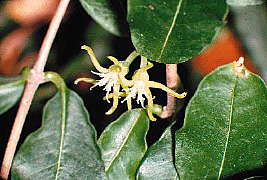|
There are 6 species of Fockea, (with numerous synonyms) found in tropical, Eastern and Southern Africa. They have swollen, sometimes warty, tubers, which in their habitat grow underground, and branching stems with opposite leaves. The stems readily exude a milky latex (12% rubber) when bruised.
The tubers of several species are edible and eaten (roasted) by the Hottentots despite the latex, which flows in copious amounts from broken roots. Cooking is reported to inactivate the latex.
|

large tuber |

crisped foliage |

flower |
Above: Fockea capensis Endlicher 1839 Syn. F. crispa K. Schumann 1895
was first described by Carl Thunberg in 1794 as Cynanchum crispum and renamed in 1839. Fockea crispa (revised to Fockea capensis) is a popular, easily-grown caudiciform succulent, and its warty tubers can become very large (e.g. 60 cm). The young stems crinkled leaves of Fockea crispa are slightly pubescent. However, most specimens of Fockea capensis have smooth green leaves and F. crispa seems to be a rare variety. The small five-lobed yellow flowers are sweetly scented and attract hoverflies.
Some authorities regard F. capensis as a variety of F. edulis.
|

Fockea edulis K. Schumann 1895 (Hottentot bread)
Syn. Fockea cylindrica R.A.Dyer
has smooth tubers from which arise several twining stems with opposite leaves, which are oval, smooth and glossy compared with the crinkled leaf form of F. capensis.
The sweet-smelling flowers are about one quarter of an inch (6 mm) across and a pale cream colour. In England they appear freely in the early Autumn, but are not particularly showy. In England F. edulis retains its foliage and even grows during the winter when kept just frost free. A little water is required during the winter to prevent the foliage from 'self-pruning'. |
|
A gritty compost with some humus is suitable. The tubers are best planted on the surface of the compost, and the vegetative growth allowed to twine around supports which should be larger than initially appears to be necessary as the foliage will outgrow almost any support provided. The foliage attracts whitefly, and periodic spraying with an insecticide or fumigation may be required to control this problem. Also watch out for mice.
Growth of the tubers to a showable size is faster if they are buried in the compost, which can be partly removed for showing. To increase the size of the tuber at a measurable rate, the plant should be well fed with high nitrogen fertiliser. Tubers do not seem especially prone to rotting but can collapse suddenly. A minimum over-wintering temperature of 5°C is adequate providing the plants are kept fairly dry. Several species retain their leaves throughout the year, although this depends tremendously on the cultural conditions.
Vegetative propagation is difficult to impossible, and the plants are dioecious so one of each sex is needed to obtain seed. However, Fockea seed grows easily and is the best method of propagating these plants. |

 Families of Succulent Plants
Families of Succulent Plants 




 Families of Succulent Plants
Families of Succulent Plants 


